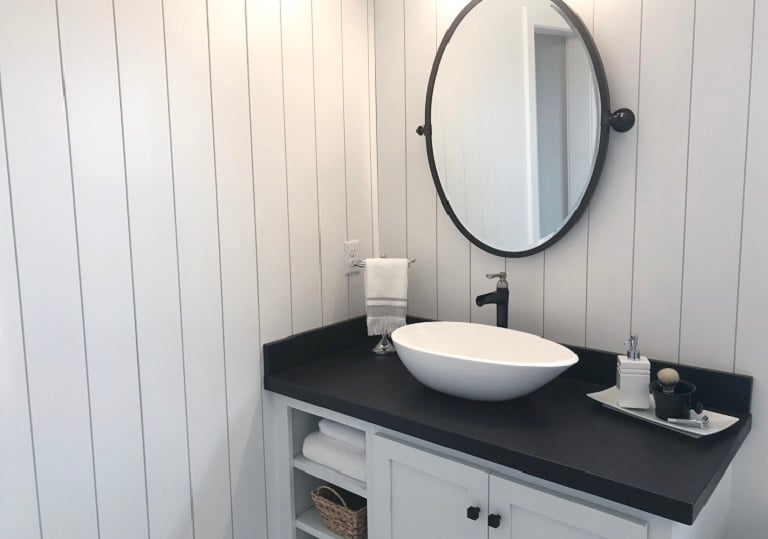What Is Shiplap?
Shiplap is a special type of overlapping wooden board that uses a “rabbet” groove that slides into place, is self-spacing, and creates a waterproof surface


Most often found in exterior siding, shiplap has recently become a hot interior design topic for onscreen home rehabbers and rustic decor enthusiasts alike. Much of what you see, especially on TV, imitates the look without meeting all the criteria.
These generalizations can muddy the true meaning of shiplap, so even if you’re familiar with the term, it’s worth taking a deeper dive.
What Is Shiplap?
Maybe you’ve seen those rustic renovations with whitewashed wood paneling. That’s shiplap, right? Well, not quite (or not always, we should say). Referring to all types of wood paneling as “shiplap” is painting it with too broad a brush. All shiplap is wood paneling, but not all wood paneling is shiplap.
The term “shiplap” comes from its original use as waterproof wood paneling for ships. A rabbet, or groove, cut at the top and bottom of each plank allows the boards to fit snugly together. When installed horizontally, this makes them perfectly self-spaced and creates a highly effective barrier against wind, water, and other elements. Your basic wood paneling? Not so much.
What Is Shiplap Siding?
The weatherproof quality of shiplap makes it a great choice for your home’s siding. When comparing the pros and cons of different house siding options, you’ll notice that wood is a durable choice with a natural aesthetic that many homeowners find appealing.
However, the cost of shiplap is on the higher end, and you’ll need to make the extra effort to maintain your siding’s beauty. For those farmhouse fanatics, though, it’s worth the extra time and dollars. A siding contractor near you can fill you in on all of your options.
What Is a Shiplap Wall in Interior Design?
This is where a lot of confusion can happen: What is a shiplap wall versus one created with regular wooden boards? After installation, the difference is nearly undetectable, as the rabbets become hidden once they’re fitted together.
Unless you’re a shiplap purist (they definitely exist), you can get the same rustic look from basic wooden boards. Just be careful to avoid the misnomer, especially around your carpenter friends.
What Is Shiplap Wood Made From?

We’ve covered the fact that not all wood paneling is shiplap—so, what type of wood is shiplap? There’s no “shiplap tree” per se: Shiplap can actually come from a variety of woods, such as cedar, plywood, redwood, and more. The distinction lies within the rabbet-grooved design rather than the type of wood that makes it up. Again, you can imitate the look with plain wooden boards, but it’ll require some extra spacing and leveling before you nail it in.
Shiplap Pros vs. Cons
Like most materials for the home, there are pros and cons to consider before taking on a shiplap project. Below are some of the main points to keep in mind.
Pro: You Might Already Have It
If you have an older home, you may have shiplap paneling located behind the plaster. If this is the case, it’s usually quite salvageable. Who doesn’t love free shiplap? We’re not saying to take a sledgehammer to your walls but watch for it if you’re already in the process of restoring or renovating the space.
Pro: It Makes the Perfect Accent Wall
A shiplap accent wall creates the perfect farmhouse-style focal point in just about any room of your home. Here are a few projects ideas if you’re looking for some inspiration:
A shiplap wall above your fireplace
A shiplap kitchen accent wall with tile backsplash around your sink/counter area
A nautical-themed powder room accented with a shiplap wall
A shiplap wall behind your bed’s headboard
Really, you can put a shiplap wall almost anywhere around the home. If you’re using salvaged wood, though, avoid chronically damp areas like your bathroom or basement.
Con: It Can Attract Dust
Rabbets can lead to dust bunnies. You’re looking at many slight gaps with a shiplap wall, and these create the perfect gathering spots for stray dust particles. Maintaining a regular schedule with your feather duster can keep this problem at bay, but it’s worth noting if you’re considering shiplap for your next project.
Con: It’s a Complex Painting Project
While it’s perfectly beautiful in its natural state, some homeowners prefer a clean and painted look. White is a particularly popular choice for painting shiplap. If you’re going this route, take care not to apply too thick of a layer. Paint can easily settle in the spaces and create a goopy mess if you apply too much at once.
Shiplap: The Bottom Line
Your favorite TV stars, and possibly some of your pals, might refer to any wood paneling as shiplap, and it’s easy to see where this mistake happens. Still, the real thing is often heavier, harder to find, and more costly, so those are your main sacrifices to consider.
If you’re on a budget though, what’s in a name? You can achieve a very similar and nearly indistinguishable look with plain old wooden boards. Just don’t say it’s shiplap—or better yet, simply admire its beauty without giving it any name at all.





- 19 Shiplap Wall Ideas to Match Any Interior Decor Style
- 5 Tips for Keeping Your Shiplap Walls Dust-Free
- How to Install a Shiplap Ceiling
- What’s the Difference Between Shiplap and Drywall?
- Everything to Know About Shiplap vs. Beadboard So You Can Choose the Best One for Your Home
- Shiplap vs. Tongue and Groove: Which Is Best for Your Project?
- 18 Stylish Wall Paneling Ideas
- 12 Alternatives to Drywall for Your Renovation
- How to Cover Wood Paneling: 4 Simple Methods
- 10 Types of Wood Siding: Which Is Best for You?










